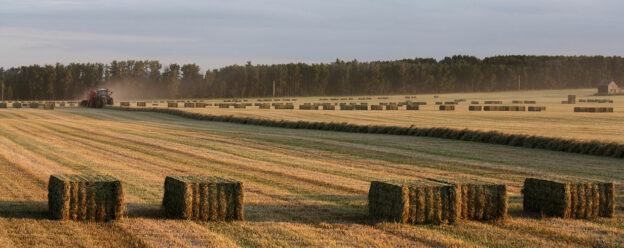There are many benefits of high quality forage, as the saying goes: you get what you pay for. You can reverse that statement by saying you don’t get what you don’t pay for. Or even that you could pay for it later! Studies have shown that when dairy producers invest in high quality forage they will see a valuable return on that investment.
Choosing High Quality Forage
Optimal animal performance can improve with high quality forage. It is essential for weight gain, producing higher levels of milk, increasing reproduction success, and farm’s profits. It’s important to give your dairy cows the appropriate type and amount of feed according to their specific nutritional needs. Factors that could help define these needs include: sex, age, species, and production status.
When choosing your high quality forage for either beef or dairy cows it’s also important to think about the follow factors: whether the cows will eat the feed, how much of the feed they will actually eat measured against how much energy is required for their specific activity (milk production, breeding, beef production, etc.), digestibility, nutrient content, and any negative factors the forage might have on a specific cattle group.
High quality forage performs at its best when it is harvested young. As crops like alfalfa mature the fiber content increases, lowering the quality. Forage that is too high in fiber slows digestion. With slower digestion the animal will not take in as much and might not consume enough energy to meet their activity requirements.
High Quality Forage Boosts Milk Production in Dairy Cows

Milk production has high nutrient demands on dairy cows! Dairy cows have to consume large quantities of food to consume enough energy to keep producing milk. In some cases a dairy cow cannot physically eat enough feed to meet the requirements of milk production; and the cow’s body fat could start depleting in an attempt to meet those energy requirements. This is a problem.
High quality forage like Alfalfa hay can greatly benefit dairy cows and milk production. Alfalfa hay contains less neutral detergent fiber and is more digestible. Also, high quality forage like early harvest alfalfa is lower in fermentable fibre and passes through the digestive system faster, allowing the cow to consume more. That means dairy cows that consume high quality forage are able to increase both their energy intake and total milk produced. Talk about getting your cake (alfalfa hay) and eating it too!
Milk that is produced with a higher fat concentration is can usually be sold for a premium. Since high quality forage is high in the right type of fiber it also supports milk fat production, which in turn affects the producer’s bottom line.
A study came out of the University of Wisconsin that was able to conclude that the milk response of dairy cows fed different levels of alfalfa forage quality was improved when fed more high quality forage. They were able to prove that high quality forage contains more energy and also allows dairy cows to eat more!
The study also tested adding a concentrate like grain to lower quality forage to try to offset reduced milk production resulting from low quality feed. High producing dairy cows are sometimes fed concentrates to help boost the energy content of their feed. Even adding this concentrate could not improve the results of the feed. Here are their examples:
Early bloom alfalfa with 54% concentrate produced almost as much milk as pre-bloom alfalfa with 20% concentrate, but no amount of concentrate would produced over 70 lb of fat corrected milk from mid or full bloom alfalfa. Further, the 71%-concentrate formulations are not sustainable, due to animal health problems associated with low fiber.
They also found that the actual fat concentration of the milk produced fell as the added concentrate increased. With milk with high fat concentration going for top dollar, adding too much concentrate to the feed could affect a dairy producer’s profit.
View their study results and further research on high quality forage.
Sources: http://www.extension.org/pages/26278/in-vivo-digestibility-of-forages, http://extension.umass.edu/cdle/fact-sheets/harvest-management-high-quality-alfalfa-hay




